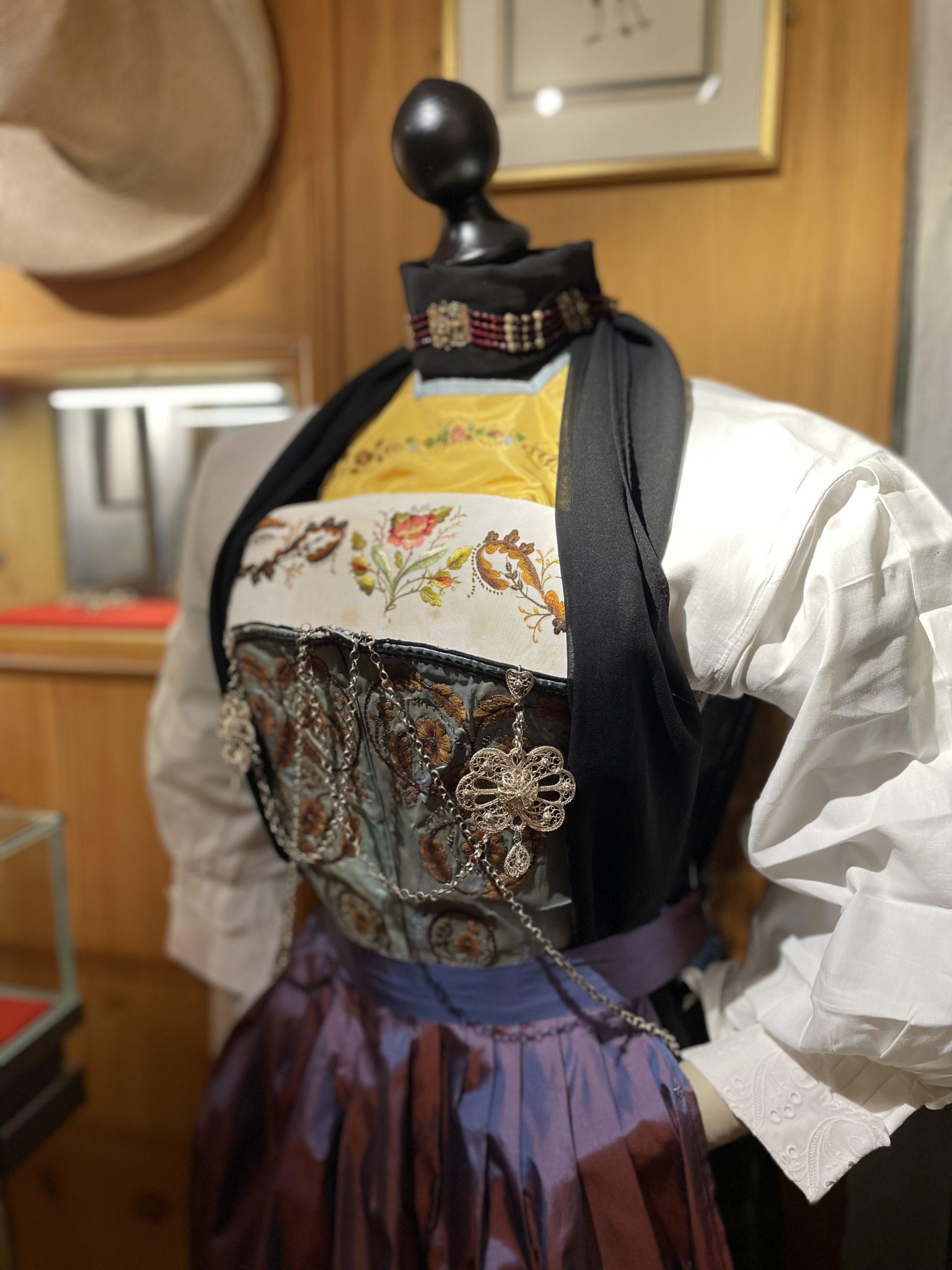The History of the Building
The History of the Building
A residential building has been on this site since the 15th century. Because of various stages of construction, additions and modifications, the house that emerged in 1786/87 was virtually a new structure. It was modelled on the traditional Engelberg farmhouse. It did not attain its current appearance as a Wappenhaus until 1936/38, when the blazon of the Engelberg burgher crest was placed on the façade and the municipal coat-of-arms of Engelberg was put in the pediment.
The aim of the restoration in 1988 was to correct disruptive modifications on the exterior and interior and restore the uniform look of the house.
The exterior
Initially without shingles, the building dating from 1786/87 had small, coupled windows and a building inscription carved into the pediment using a chip carving method known as kerb-schnitt.
There were two outbuildings on the site until about 1890: a wooden shed toward the slope and a small stable toward the Schwandstrasse. Until that year, the house had been covered by a shingle roof held in place by overlying logs with heavy stones. An addition was added to the rear of the house about 1890 and the roof was redone in tiles and partially re-edged.
The interior
The interior shows a typical well-preserved Engelberg home. In the kitchen and smoke room, the open flue was restored. When the wall in half-timbered construction was exposed, the old block staircase in the hallway was able to be reconstructed. This modification restored the interior to the way it looked to inhabitants at the end of the 18th century.

Relief of the Engelberg Region 2008
Relief of the Engelberg Region 2008
Scale: 1: 10,000
Toni Mair (1943-2015), Geomodelia Reliefbau Atelier GmbH, Unterägeri
Gifted by the Fritz-Carl Wilhelm Foundation.
The relief builder Toni Mair created the relief of the Engelberg, taking over 1200 hours to complete.
A master of his craft, which is so rare today, he worked for multiple Universities and Museums throughout Europe. The corner points of the relief, measuring 3.75 square meters in size and weighing 300 kilos include Gitschenen (Northeast), Krönten (Southeast), Flüeli-Ranft (Northwest),
And Melchsee-Frutt (Southwest).
The national Maps 1:25,000 and sterio aerial photos, which are systematically taken by Helicopter, served as Templates for the creation. A rough version of the relief is then created in the studio.
To do this, each contour line of the National Map is transferred to plywood them manually sawn out.
A negative mold is then made from Silicone rubber. A plaster model is then cast from this negative, and finally precisely carved and remodeled.

The Engelberger Relief
The Engelberger Relief
Scale 1: 20,000 85x98cm, 1811
Composition: Plaster, Mirrored glass, metal pins, oil paint, wood.
On permanent loan from the Zürich Central Library.
The so called “Engelberg Relief” is one of Joachim Eugen Müller`s main works. The central fixed point of the calculations and angle measurements for the relief was the Titlis. The relief shows mountains, glaciers and valleys around the village of Engelberg in a detailed manner. The creation of a detailed and true to scale relief required extensive preparatory work. Müller`s field books and measuring tools bear witness to this. The relief was made by his well known “nail technique” where he would hammer in pins to the hight of the mountain peaks, then pour a mass consisting of plaster, sand, wax, lime and resin over the surface. After the mass had cooled, he began working on the relief from top to bottom with a coarse, spoon-like instrument. First the peaks, then the valleys. The exact reproduction of the mountain forms and the careful depiction of the details characterize Müller`s work.
Shortly after the relief was completed, around 1811, it was presented in an exhibition in Zürich. A letter from Escher from the Linth( scientist, artist, Politician and Swiss Alp surveyor) shows that the relief was in Escher`s house in 1814. Müller even gave the work to his friend Escher whom he had helped measure the Linth canal, but he declined due to it being too large. The relief finally became the possession of the Zürich Central Library, but now has been returned home on permanent loan to the Valley Museum.

Smoke Kitchen
Smoke Kitchen
The smoke kitchen shows the actual appearance of a kitchen from the late 18th century. The enclosed cast-iron cooker from 1900 and the tile stove were rendered heatable again. The kitchen sideboard crafted entirely of wood deserves special attention in this room, as does the Late Baroque roulette game from Engelberg dating to the late 18th century.
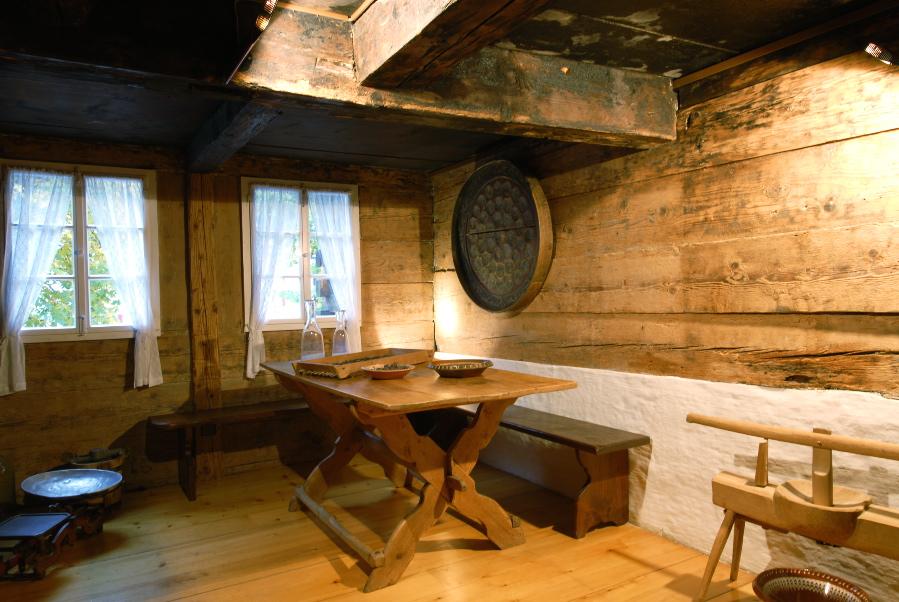
Farmhouse Parlour
Farmhouse Parlour
The well-preserved farmhouse parlour shows how a prosperous farmer family in Engelberg once lived. The furniture spans the period from Late Baroque to Late Biedermeier. The buffet and tile stove are fine pieces and date back to about 1786/87, the period in which the home was constructed.
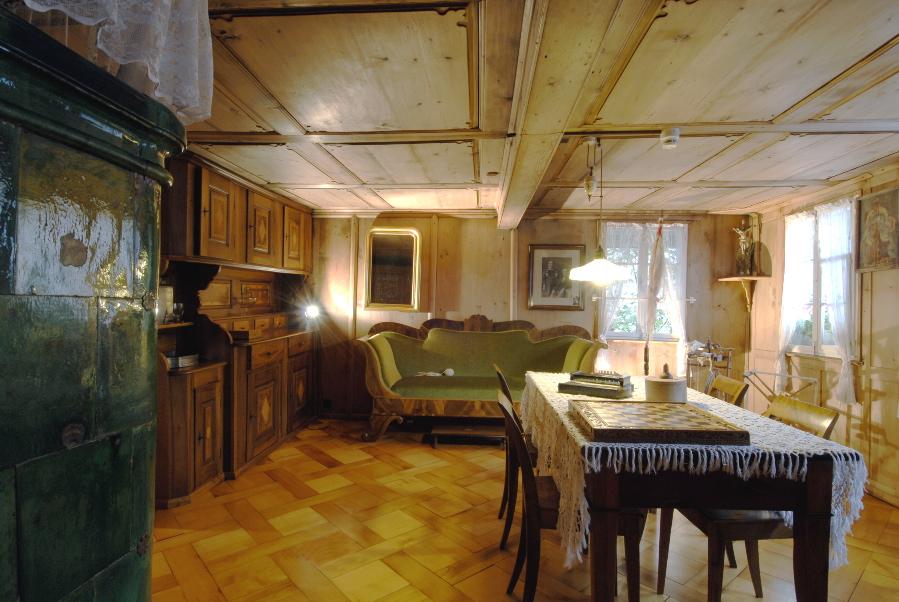
Sleeping Room
Sleeping Room
The sleeping room vividly shows just how cramped sleeping arrangements could be. All sleeping spots have the traditional bedding featuring a sack of leaves as a mattress.
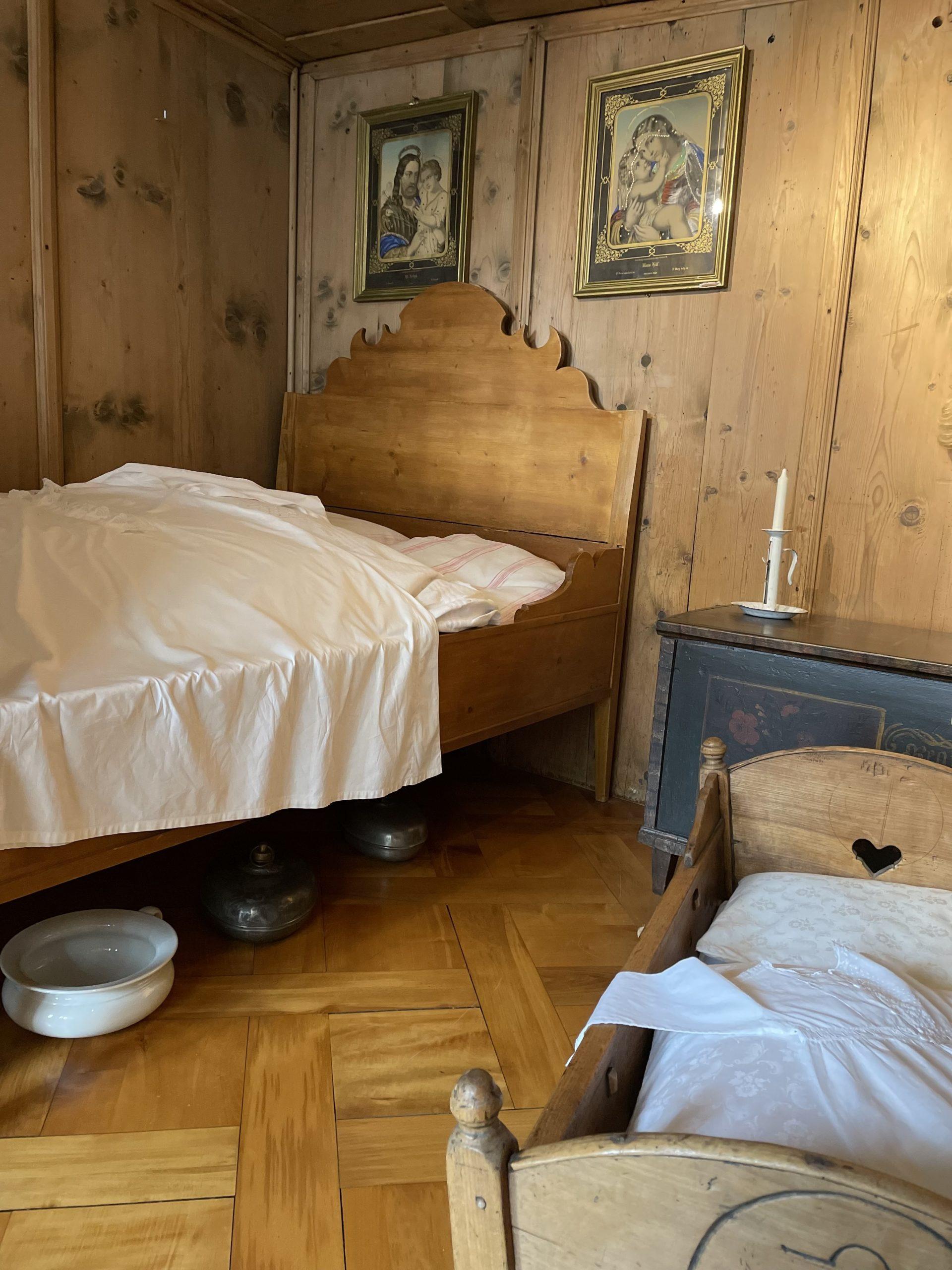
The Origins of Swiss Traditional Dress
The Origins of Swiss Traditional Dress
Traditional costumes go back to the regional, rural clothing that was worn at the end of the 18th century- before the start of the Industrial revolution and Textile production. The style was influenced by the courtly French Rococo fashion, which reached the countryside via the cities and local upper classes. Bodices, lintels (stiffened breast cloth, tucked into the open bodice at the front), Lace Bonnets, Straw hats, buckled shoes, tight fitting necklaces, the use of Damask, Brocade and silk embroidery are all typical Rococo elements found in many costumes. Since Engelberg and Nidwalden form a geographical and cultural unit, a regional costume developed, which at the end of the 18th century had the following elements: a stiff, red or blue bodice with an embroidered front pin, a red skirt, an apron with colourful silk ribbons, a black Neck tie with a close- fitting necklace with hanging rosettes (see showcase).
Early 19th Century
The French Revolution also brought about a major upheaval in fashion history: stiff bodices disappeared. Based on ancient models, in Empire fashion the waistline is high, just under the bust. The clothes fluently emphasize the body contours. (Empire: French Empire under Napoleon, 1804-1815). At the same time, in the Romantic era, people began to idealize the Alps and their inhabitants. This is how many depictions of traditional costumes emerged, on which the influence of Empire fashion can be clearly seen: the bodices are no longer stiff and the waist is set high under the Bust. During this period, a new element appeared in the regional costume: a narrow belt that fastened sideways. Among other things, the lintel, Straw hat and Jewellery have been retained. Throughout the 19th century, traditional costumes followed fashion trends, which spread quickly thanks to industrialization and mass production.
1815 – Mid 19th Century
The restoration that began at the end of the Napoleonic era in 1815 brought an attempted return to the old order, not only in politics. The Biedermeier fashion returns to the strongly emphasized female figure: waists are laced up again with wide falling skirts, later crinolines (hooped petticoats). The regional costume follows the fashion: the belt, which was actually supposed to cover the transition between the bodice and the skirt, becomes wider and wider and thus emphasizes the laced waist, this is called a Tschäpper, and it becomes a feature of the costume. The bodice is again stiffened with Whalebone or Horsehair. Now, in Engelberg there is a discernible difference to the Nidwalden costume: the Engelberg plaited braid Ribbons are white instead of red like the trimmings worn in Nidwalden. The different colouring is possibly a sign of belonging to Obwalden, which has existed since 1815, because the unmarried Girls there wear a plaited Hairstyle with white Ribbons (see round display case).
2nd Half of the 19th Century
With the formation of the Federal States in 1848, a period of increasing industrialization and urbanization began, which led to the displacement of pre-modern living environments and cultural levelling. In fashion, waists are laced ever tighter(hourglass waists), The Tschäpper continues to grow into a kind of second bodice, the lintel is pushed up and strongly arched. From 1870 the pleated sleeves appear. Fashion influences lead to mixed forms and an ornamental overload of ruffles, strands, padding and appliqués etc…Hair ornaments and neckties take on almost enormous proportions. Towards the end of the century, a gradual suppression of traditional costumes becomes noticeable: Often only the jewellery is worn with industrially manufactured clothing, which is perceived as modern-an indication of the slow disappearance of rural culture and tradition. Attentive observers register this “dying out of traditional costumes”.
Shepherd’s Shirt and Traditional Blouse
A traditional blouse made of linen with the starched sleeves laid in accordion folds, as they were also worn in Engelberg with the Tschäpper costume. For storage, the starched folds were fixed with a basting seam. The blouse was treated like this in the mid-20th century and then discarded. In Nidwalden, the sleeves of the peasant costume are still worn this form, while in Engelberg the «soft” sleeves are worn with both costumes. The Central Swiss shepherd’s shirt developed over the course of the 19th century from the simple Burgundy, a blue linen shirt without a hood with a shoulder yoke. The Burgundy came to Switzerland via France at the beginning of the 19th century. Over time, this work smock developed into the festive “Hirthemli” made of brown or black plush wool with embroidery on the neck and cuffs. By the end of the 19th century the form developed as it is still worn today. In the late 19th century, a traditional tie, swallowtail, in the form of a bowtie made of black silk taffeta was worn with the shepherd’s shirt. In the current form of the costume, this tie is replaced with two pompoms.
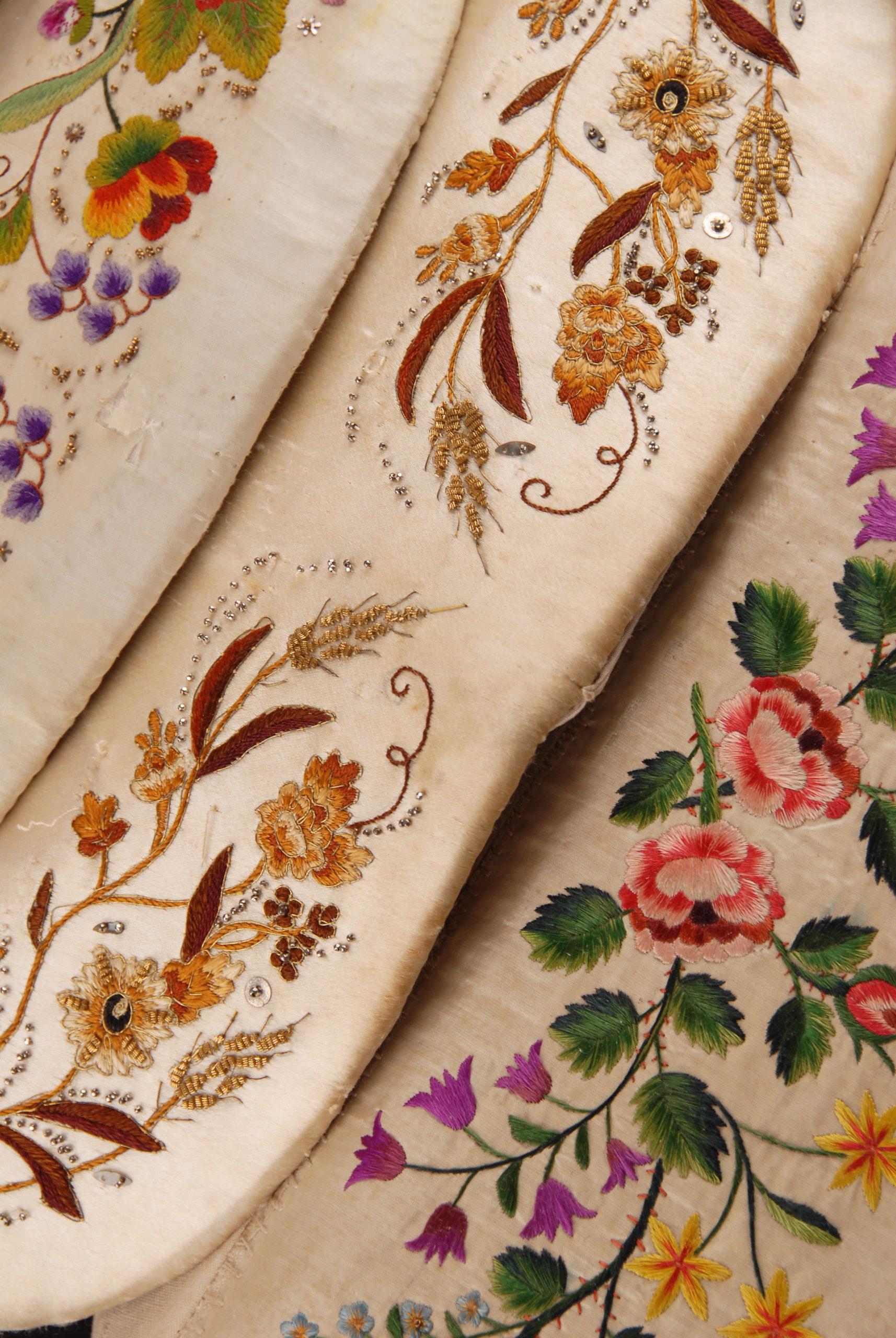
The History of Engelberg Valley: Settlement
Settlement
Stone splinters, arrowheads and an Axe found in the Trübsee/Jochpass area show that the Valley was used as a passage in early prehistory. From around 600BC the Celts (Helvetii) settled in the Swiss region. Very old local field names like Gerschni(1) or Alpelen(2) have Celtic roots. In the 1st Century AD, the territory of the Helvetii was incorporated into the Roman Empire. There is a fusion between the Celtic and Roman population, culture and language. Field names like Zingel (3) or Planggen (4) come from this period. In the wake of Human migration, the Alemanni reached Central Switzerland around 700AD. The Germanic Alemanni call the Celtic-Roman population who speak differently “Wal (Den” (Welsh/foreign): Wallenalp and Wallenstöcke (5) get their names from this. The origin and history of the various field names show that the Alpine region was used for summer grazing very early on. Otherwise, the area remained largely an untouched wilderness until the dawn of the Middle Ages.
In the 8th and 9th Century the valley floor was reclaimed and the wilderness pushed back. Field names such as Schwand or Schwändli (6) (from “wasting” i.e “to vanish”), Bränd (7) (“cleared by fire”), Riiteli, Rüti, Fellenriiti, Herrenrüti (8) ( from”repented” i.e “cleared”) trace back to these efforts. During this time, the valley, together with the Alpine rights that already existed at the time came under the rule of various Earldoms from the lowlands. They pushed ahead with the development and sent more settlers to the high valley for this purpose. The valley floor is divided into various estates or farms, each of also includes Alps. One if these estates was owned by the Barons of Sellenbüren, a noble family from the Zürich area, in the 12th Century. In 1120, Konrad von Sellenbüren, the last of his family line, donated his entire estate to the Benedictine monastery.
The History of Engelberg Valley: The Engelberg Abbey
The Engelberg Abbey/ Monastery
Monks from the Muri monastery helped to found the convent in Engelberg. At that time, Muri owned numerous Alps in the valley, which Konrad von Sellenbüren purchased and bequeathed to the new Benedictine Abbey, which owned extensive property and land in Engelberg, Nidwalden, Luzern, Aargau and Zürich. As early as 1124, the Pope and Emperor confirmed the founding- equipped with free election of Bailiff and Abbot, the monastery is not subject to any secular power and so Engelberg achieved its special position of independence in the Old Confederation (from 1425 as a dependent place). Which will last until 1798.
The Engelberg monastery is designed as a double monastery. This institution unites separately housed convents of monks and nuns under the joint rule of Abbot Magistra (Mistress). The women`s convent of St. Andreas has been in the Wetti region since the early 13th Century. Both convents are supplied with goods from the foundations and donations. Monasteries are seen as centers of knowledge, book production and spirituality. In the late 12th Century, the scriptorium of the mens convent were privileged to have had two particularly impressive masters at an early flowering stage. In the following centuries, more magnificent works were created. In the library of the women`s convent there are early versions of the works of Upper Rhine mysticism, in which personal prayer in the mother tongue plays a major role. The Engelberg prayer book from the 14th century contains some of the oldest private written prayers in the German language. The Engelberg double Abbey has been ravaged by fires and the plague over the centuries. Numerous social, political and economic changes jeopardize its existence. But it was not until 1615 that the women’s convent was moved to Sarnen. The Engelberg double monastery remains one of the longest in history.

The Histrory of Engelberg Valley: The Valley People
The Valley People
During the Middle Ages and early modern times, the valley was under the rule of the monastery. Economic and political processes influence and shape the relationship between the church and the subjects. The form of rule changes over time, as does the self-image of the valley people. Monastic rule is based on manorial rule-the lord has land, ruling and administrative rights. He allocates land for use and the land recipients pay tribute in the form of payment in kind, interest payments and/or working hours. Land recipients can be both free and bonded; Taxes due can be attached to the person or the land(tenancy). It was not always an advantage to farm land as a free man, which is why it could happen that serfdom was deliberately sought. Manorial rule was influenced by many factors and processes and was accordingly changeable. Extreme notions of benevolent monastery rule or feudal oppression hardly do justice to historical reality.
A slow softening of the system can be observed. Inheritance plays an important role here. Instead of being regularly reallocated, land remains habitually in the same family. While feudal burdens lie further afield, it can be inherited and so slowly “eaten». Economic developments strengthen the position of farmers, lower interest rates are negotiated. Along with the weakening of manorial rule (serfdom), efforts for more autonomy and participation began in the 15th century. The valley law is recorded in writing, the valley dwellers receive a mayor and a say in the appointment of the court. At the beginning of the early modern period, the development of a municipal self-confidence can be observed, which is expressed not only politically but also politically and socially in foundations and donations that are made in the name of the “Gmeine Thallüt alhie zuo Engelberg” a testimony to a humble new prosperity.

The History of Engelberg Valley: The View of the Mountains
The View of the Mountains
Renaissance and humanism, the printing press and voyages of discovery to the east and west brought about the turning point from the Middle Ages to the early modern Era in the 15th century; an epoch that established a new, modern understanding of nature. A development that began in the scholarly offices of humanism became significant for Engelberg; natural philosophy, the forerunner of modern natural sciences. Suddenly, nature is no longer perceived as a hostile place full of threats, but as an object of wonder and scientific investigation. The Alpine Mountain world turns from a place of horror to a place of amazement. Now not only pilgrims come to Engelberg, but also travellers whose gaze is no longer directed inwards, but outwards at the landscape and mountains. Travel descriptions and first attempts to capture the landscape and topography in pictures are created. The famous, probably oldest depiction of the monastery by Matthäus Merian comes from such a travelogue; the Topographiae Helvetiae published in 1642.
The century of Enlightenment led the natural-philosophical view of the Alps to a scientific view that values measuring, observing and analysing. The first ascent to mount Titlis in 1744 is further expression of this scientific approach to the mountains. At the end of the 18th century, the first map series of Switzerland based on scientific surveys, the Atlas Suisse was published. The Alpine maps are based on notes, sketches and reliefs (ground floor) made by Joachim Müller from Engelberg. In the course of the 18th century, this scientifically sober view was joined by a sentimental perspective. Romanticism attributes uplifting, liberating, and healing powers to untamed nature. Painters and poets are inspired by the mountains and their inhabitants and often celebrate their beauty and unspoilt nature in dramatically exaggerated landscape views or idyllically transfigured depictions of the traditional way of life.

The History of Engelberg Valley: Political new Order
Political new Order
At the turn of the year 1797/98, the French revolution finally reached the Old Confederation when troops of the Estea Republic crossed the border. Subject areas and common rulers find their way to freedom, old forms of rulership begin to falter-also in Engelberg. The Monastery makes some concessions, but otherwise insists on retaining the “old law”. With the defeat in Grauholz on March the 5th 1798, the days of the Ancien Régmie are finally numbered. The Helvetic Republic- with its equality of rights, separation of powers and popular sovereignty-based constitution takes shape. Feudal and oligarchic forms of rule are abolished; on March 30th, Abbot Leodegar Salzmann renounces all power. On April 5th 1798, the valley community accepts the new constitution. In July, Engelberg becomes part of the district of Nidwalden in the newly created county assigned to a forest site.
The loss of political power and independence, concerns about religious identity and reluctance to follow centralized directive fuelled resistance to the new republic, especially in central Switzerland. Despite pressure from Nidwalden, Engelberg takes the Swiss citizenship oath on August 23rd and is spared the French storm that rages through Nidwalden on September 9. In the following phases of Helveticism and mediation, the valley now belongs administratively to Nidwalden.
In 1813 the system of states created by France collapsed and Europe was reorganized. Tedious negotiations for a new constitution begin in Zürich, are hampered by forces demanding a return to the “old order”. In Nidwalden, a reactionary takeover of power leads to radically chaotic conditions, leading to Engelberg changing counties to Obwalden in the summer of 1815. When Nidwalden joins the new federal state in late summer after the intervention of federal troops, Engelberg s affiliation to county Obwalden is not renegotiated- the municipality remains an Obwalden exclave.
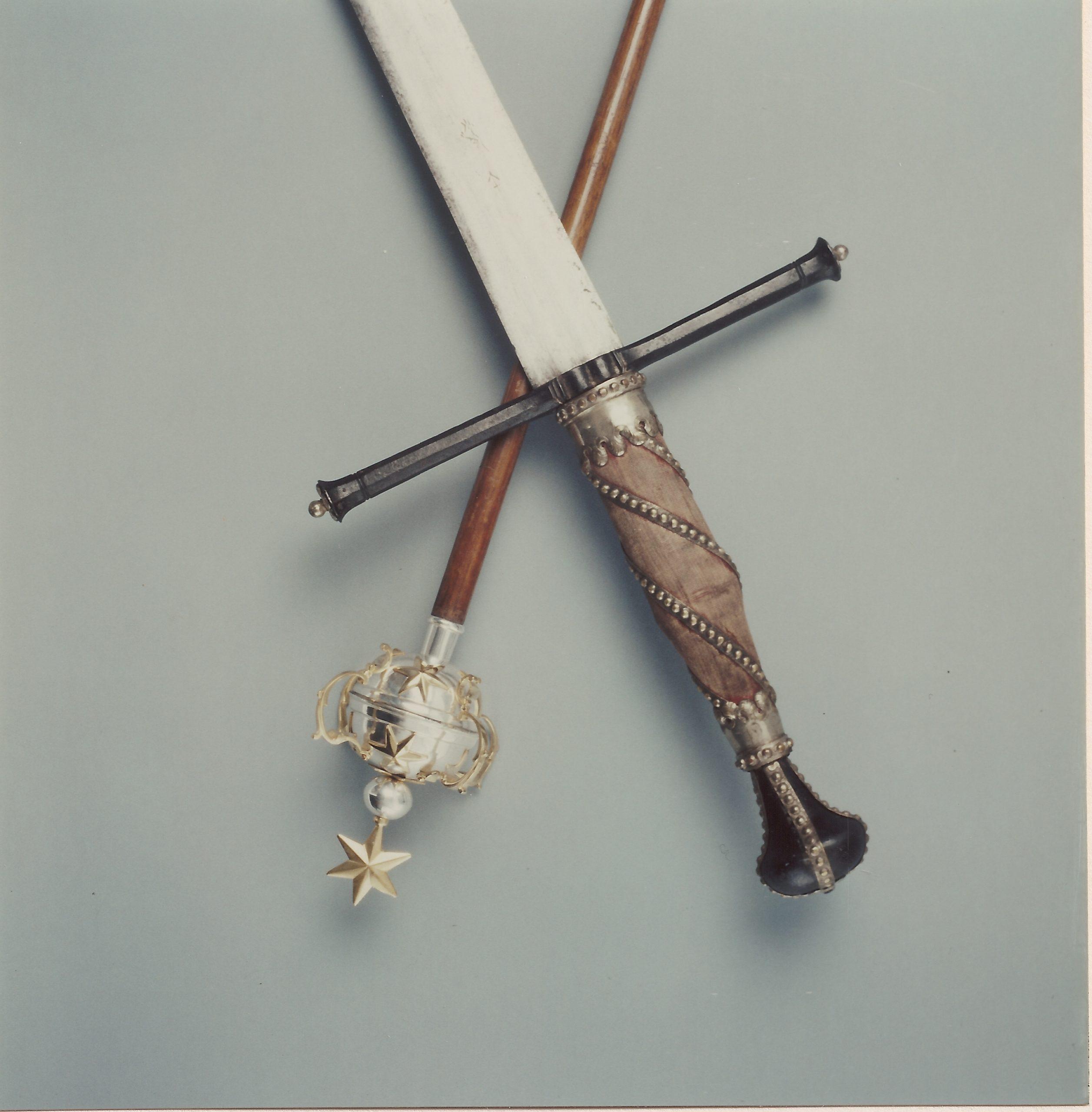
The History of Engelberg Valley: New Horizons
New Horizons
Around 1840 a new chapter begins for Engelberg. Doctor Carl Cattani converts the Guesthouse Engel, run by his family into a health resort. He advertises the healing properties of the “air and altitude health resort of Engelberg” at home and abroad. The health resort, based on the idea that nature has healing powers, brings an increasing stream of guests into the valley, hoping to be healed of numerous ailments. From the middle of the 19th century, the expansion of the European railway network and the economic boom made traveling a pleasure. Previously a privilege of the nobility now affordable for the aspiring bourgeoisie. One travels to the mountains for a “summer retreat”. In order to meet the needs of this discerning clientele, the first grand hotels were built in the 1860s: the Sonnenberg and the Titlis, both designed in the style of aristocratic palaces and equipped with numerous halls, salons and spacious parks. The following decades are marked by a veritable building boom that changes the village dramatically: new hotels and commercial buildings are built; additional parks and a network of walking paths are created. New economic opportunities are opening up for the population. The needs of tourism lead to a constant expansion of the local infrastructure, which is often promoted by the Kurverein (tourism council) founded in 1883. Engelberg is connected to the telegraph and stagecoach network in 1869. Private power plants are built to supply the larger hotels with light. The first telephone line is put into operation and with the construction of the Stansstad-Engelberg railway, it is connected to the European rail network 1897/98.
Shortly thereafter, the first official winter season takes place: guests now also come in winter, the first winter sport facilities (ice rinks, toboggan and bobsleigh runs) are built. In the age of Luxury liners, Engelberg s magnificently equipped trains and hotel palaces make it a sophisticated destination for the European upper class and the number of inhabitants increase significantly. The golden phase of the Belle Epoque ends abruptly in 1914 with the outbreak of the First World War.
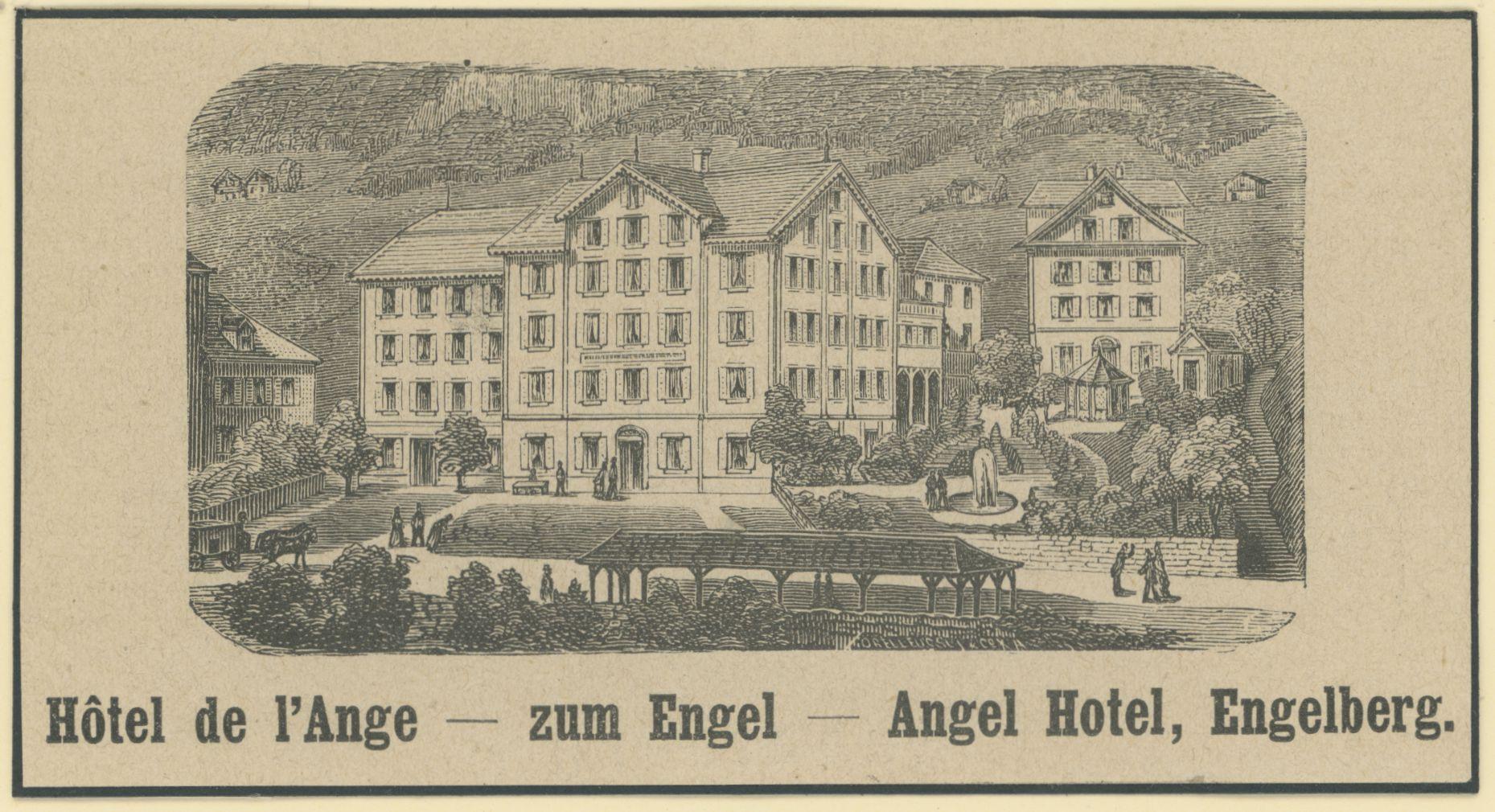
The History of Engelberg Valley: The Way to Modernity
The Way to Modernity
The First World War caused far -reaching political, cultural and social upheavals. Modernity has reached the Engelberg valley in many forms: the call for physical exercise to promote health has given sport and sunbathing a new meaning. In the 1920s, large-scale tourism facilities with a pioneering character were built in Engelberg: The Gerschnialp-Trübseealp cable car and the Sonnenberg swimming lido. The number of day-trippers is increasing and with them the number of vehicles. Long staying guests now prefer smaller, modern guesthouses or private accommodation. There are holiday homes in the form of traditional chalets or bungalows in the new building style. The tea room in the village, designed by the graphic artist Herbert Matter for his parents, is also committed to the new building style, here modern music also makes its way: it is a meeting place for international Jazz Artists. Matter also designs legendary advertising posters for Engelberg (e.g., the woman with the Norwegian glove)
In the 1940`s and especially after the Second World War, the urge to modernize increased and an intensive growth phase began. Cable cars open up Ristis (1952) and Small-Titlis (1967) for mass tourism; More sports facilities are being built and continuously modernized in the ski areas on both sides of the valley. In the 1960s, the transport infrastructure improved further with the direct train connection to Luzern and the connection to the motorway network in Nidwalden.
Old Hotel buildings and parks disappear and the Village centre is redesigned with the construction of Klosterstrasse. Outside the Village, compact housing developments with holiday apartments are being built, while elsewhere there is a trend towards urban sprawl. The construction boom of the boom years leads to problematic developments. From the mid-1970s, a change in thinking began that finally made it possible to implement spatial planning specifications. At the same time, environmental protection and landscape protection are becoming increasingly topics that have to be taken into account in the ongoing expansion of tourism infrastructure.
The population, which has been growing steadily and only stagnated during the 1980s, finds its livelihood increasingly in the service sector and in trade and commerce, the share of agriculture is declining. At the end of the 20th century, the change from a rural Village to a tourist resort is finally complet

